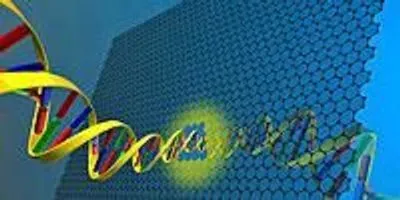 A layer of graphene is shown with a tiny nanopore drilled into its surface. Researchers at Harvard and MIT say the membrane holds potential for speeding up DNA sequencing due to its extreme thinness.Lab of Jene Golovchenko, Harvard UniversityResearchers from Harvard University and MIT have demonstrated that graphene, a surprisingly robust planar sheet of carbon just one-atom thick, can act as an artificial membrane separating two liquid reservoirs.
A layer of graphene is shown with a tiny nanopore drilled into its surface. Researchers at Harvard and MIT say the membrane holds potential for speeding up DNA sequencing due to its extreme thinness.Lab of Jene Golovchenko, Harvard UniversityResearchers from Harvard University and MIT have demonstrated that graphene, a surprisingly robust planar sheet of carbon just one-atom thick, can act as an artificial membrane separating two liquid reservoirs.
Their findings were reported this month in Nature.
By drilling a tiny pore just a few nanometers in diameter, called a nanopore, in the graphene membrane, the researchers were able to measure exchange of ions through the pore and demonstrate that a long DNA molecule can be pulled through the graphene nanopore just as a thread is pulled through the eye of a needle.
“By measuring the flow of ions passing through a nanopore drilled in graphene we have demonstrated that the thickness of graphene immersed in liquid is less then 1 nm thick, or many times thinner than the very thin membrane which separates a single animal or human cell from its surrounding environment,” says lead author Slaven Garaj, a physics research associate at Harvard. “This makes graphene the thinnest membrane able to separate two liquid compartments from each other. The thickness of the membrane was determined by its interaction with water molecules and ions.”
Graphene, the strongest material known, has other advantages. Most importantly, it is electrically conductive. (Update: On Oct. 5, Russian scientists Andre Geim and Konstantin Novoselov received the Nobel Prize in physics for their work investigating the properties of graphene. “Carbon, the basis of all known life on earth, has surprised us once again,” the Royal Swedish Academy said in its announcement statement.)
“Although the membrane prevents ions and water from flowing through it, the graphene membrane can attract different ions and other chemicals to its two atomically close surfaces. This affects graphene’s electrical conductivity and could be used for chemical sensing,” says co-author Jene Golovchenko, the Rumford Professor of Physics and Gordon McKay Professor of Applied Physics at Harvard, whose pioneering work started the field of artificial nanopores in solid-state membranes. “I believe the atomic thickness of the graphene makes it a novel electrical device that will offer new insights into the physics of surface processes and lead to a wide range of practical application, including chemical sensing and detection of single molecules.”
In recent years graphene has astonished the scientific community with its many unique properties and potential applications, ranging from electronics and solar energy research to medical applications.
Jing Kong, also a co-author on the paper, and her colleagues at MIT first developed a method for the large-scale growth of graphene films that was used in the work.
The graphene was stretched over a silicon-based frame, and inserted between two separate liquid reservoirs. An electrical voltage applied between the reservoirs pushed the ions towards the graphene membrane. When a nanopore was drilled through the membrane, this voltage channeled the flow of ions through the pore and registered as an electrical current signal.
When the researchers added long DNA chains in the liquid, they were electrically pulled one by one through the graphene nanopore. As the DNA molecule threaded the nanopore, it blocked the flow of ions, resulting in a characteristic electrical signal that reflects the size and conformation of the DNA molecule.
Co-author Daniel Branton, the Higgins Professor of Biology Emeritus at Harvard, is one of the researches who, more than a decade ago, initiated the use of nanopores in artificial membranes to detect and characterize single molecules of DNA.
Together with his colleague David Deamer at the University of California, Branton suggested that nanopores might be used to quickly read the genetic code, much as one reads the data from a ticker-tape machine.
As a DNA chain passes through the nanopore, the nucleobases, which are the letters of the genetic code, can be identified. But a nanopore in graphene is the first nanopore short enough to distinguish between two closely neighboring nucleobases.
Several challenges still remain before a nanopore can do such reading, including controlling the speed with which DNA threads through the nanopore. When achieved, nanopore sequencing could lead to very inexpensive and rapid DNA sequencing.
“We were the first to demonstrate DNA translocation through a truly atomically thin membrane. The unique thickness of the graphene might bring the dream of truly inexpensive sequencing closer to reality. The research to come will be very exciting,” concludes Branton.
Additional co-authors on the Nature paper were W. Hubbard of the Harvard School of Engineering and Applied Sciences and A. Reina of the Department of Materials Science and Engineering, MIT. The research was funded by the National Human Genome Research Institute and the National Institutes of Health.
Researchers from Harvard University and MIT have demonstrated that graphene, a surprisingly robust planar sheet of carbon just one-atom thick, can act as an artificial membrane separating two liquid reservoirs.
Their findings were reported this month in Nature.
By drilling a tiny pore just a few nanometers in diameter, called a nanopore, in the graphene membrane, the researchers were able to measure exchange of ions through the pore and demonstrate that a long DNA molecule can be pulled through the graphene nanopore just as a thread is pulled through the eye of a needle.
To continue reading this article, sign up for FREE to

Membership is FREE and provides you with instant access to eNewsletters, digital publications, article archives, and more.











